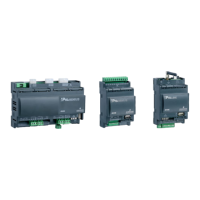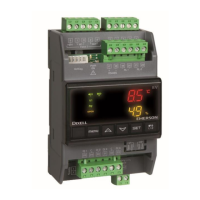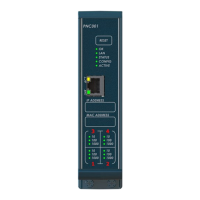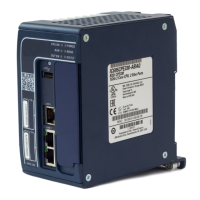Temperature Mode Software Overview • 25
10 Software Overview
10.1. Temperature Mode
In all control modes the controller is capable of switching
between two absolute case temperature setpoints, LTS et and
MTSet. The controller can be defined as either Low Temp, Med
Temp or Dual Temp by the parameter TempMode. When Low
Temp is selected, the controller always regulates to the value of
LTS et and when Med Temp is selected, the controller always
regulates to the value of MTSet. When Dual Temp is selected,
the controller can switch between LTSet and MTSet based on a
digital input or signal from E2E. To use a digital input, set up one
of the available DI as DualTemp. To switch setpoints using the
E2E, the case controller and E2E must be connected and online
via BACnet MS/TP - the network input is
DUALTEMPSELECT.
10.2. Superheat Setpoint
When the case controller is placed in a control mode that
regulates an EEV (Superheat, Standard, or Superheat Suction),
all three (3) of the available EEV control loops share a common
superheat setpoint. There is no possibility to use unique setpoints
for each of the three (3) valves. The parameter is SupHtSet.
10.3. Refrigeration Control Modes
The iPro Case Controller controls the temperature, defrost and
Superheat for the refrigerated case or walk-in box based on the
selection of the control mode parameter (parameter name=CrE).
There are five different control modes available to accommodate
the different refrigeration system designs that iPro can support. In
general, the iPro supports systems using electric expansion valves
with no suction regulation valve, electric expansion valves with
EEPR suction regulation, mechanical expansion valves with
EEPR suction regulation and mechanical expansion valves with
no suction regulation. The five different control modes are
outlined below.
10.3.1. Standard Control Mode
In the Standard mode, each case controller will manage case
temperature and the Superheat setpoints for up to three (3) electric
expansion valves per case controller. There is no suction
regulation or management of EEPR stepper valves in this control
mode. For EEPR valve management, select either suction or
Superheat/Suction control mode described below.The
management of case temperature in the Standard control mode is
accomplished by the use of setpoint and deadband control of the
refrigeration relay, which is typically controlling the system’s
liquid line solenoid valve. The control temperature in this mode is
a calculated temperature value that is compared to the setpoint.
When more than one (1) discharge air sensor is present, the
control temperature calculation method is applied to give the final
control temperature. The options for control temperature
calculation are: minimum, maximum, and average. The deadband
is split in half around the setpoint, so when control temperature is
above setpoint plus ½ of band, the refrigeration relay is set to
true/ON. When the control temperature is below setpoint minus ½
of band, the refrigeration relay is set to false/OFF. During defrost
the refrigeration relay is set to OFF.
10.3.1.1. Standard Mode Control Value
Calculation-Parameter CTM
Minimum - The controller will choose the minimum value as the
final control temperature among the available (configured and
reading) discharge air sensors.
Maximum - The controller will choose the maximum value as the
final control temperature among the available configured
discharge air sensors.
Average - The controller will perform an average of the available
configured discharge air sensors for the final control temperature.
Note that if a temperature sensor fails, all the above calculation
methods will disregard the failed sensor readings and only
calculate based on the remaining valid sensor readings.
10.3.2. Superheat-Only Control Mode
In Superheat-only mode, Superheat is controlled to a target
setpoint for up to three (3) electric expansion valves. Each valve
is managed by its own PID. Control of the superheat for each
valve is accomplished using a suction pressure transducer and
suction pipe temperature sensor (coil outlet) per evaporator to
make the Superheat calculation. All three (3) EEV PID loops
share the same Superheat setpoint, which is the parameter
SupHtSet in the refrigeration group. The PID can be tuned
manually or can be put into Auto-adaptive mode by setting the
proportional band value=0. When the P value is set to 0, the
system monitors the stability of the evaporator superheat and
dynamically adjusts the proportional band value to the optimum
number. This eliminates the need for manual tuning at every
system and can greatly reduce the time required to tune systems at
system startup.
10.3.2.1. Superheat Only-EEV Management
The Superheat control mode is designed to control the evaporator
Superheat in systems using electronic expansion valves. The iPro
Case Controller can control up to three (3) EEV, this is selected
through the value of parameter EEV Count. While in the
Superheat-only control mode the refrigeration relay is fixed ON
during the refrigeration cycle, no cycling of this relay is managed
in this mode. Refrigeration relay is fixed OFF during defrost
cycle.

